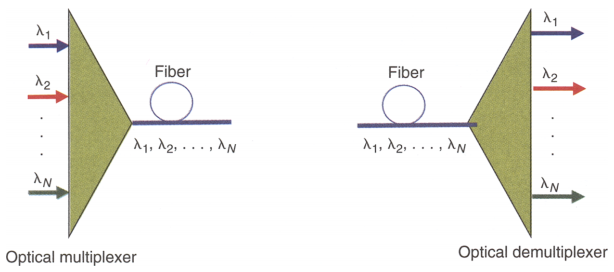The evolution of single wavelength point-to-point transmission lines to wavelength division multiplexing optical networks arose the need to separate/route different wavelength channels. What kind of device can meet this need? The answer is optical add-drop multiplexer (OADM). This device is used for multiplexing and routing different channels of light into or out of a single mode fiber (SMF). “Add” means adding one or more new wavelength channels to an existing multi-wavelength WDM signal. “Drop” means dropping or removing one or more channels, passing those signals to another network path. OADM is particularly important in metropolitan WDM lightwave services where offices or sites can be connected by different add-drop channels. It can increase the network flexibility along the optical link.
A traditional OADM has three stages: an optical multiplexer, and optical demultiplexer, and between them a method of reconfiguring the paths and a set of ports for adding and dropping signals. The multiplexer is to couple two or more wavelengths into the same fiber. The reconfiguration can be achieved by a fiber patch or by optical switches which direct the wavelengths to the add ports. The demultiplexer separates wavelengths in a fiber and direct them into many fibers.
To realize the configurations performance of adding or dropping functions, planar and fiber technology could be used. No matter what kind of devices, several factors should be considered, such as low insertion loss, high isolation, polarization insensitivity, and the cost. Planar devices provide compact solutions with the possibility of adding or dropping many channels using only one integrated optical circuit with arrayed-waveguide-grating or waveguide-grating-router. But they have the main disadvantages of high insertion loss and polarisation dependence. Comparatively, all-fiber devices are more attractive because of the low insertion losses, polarisation insensitivity and ease of coupling between output and input of the optical network by using simple splices and pigtails. But these devices are sensitive to environmental variations. There is another kind of devices based on free space optics (micro mirrors and gratings) also used to perform add-drop operations well. However, these devices have high insertion losses and cost much. So thin film filter devices have been used for multiplexing/demultiplexing applications.
OADM have passive modes with fixed wavelength (COADM) and active modes with dynamic wavelength (ROADM). In fixed wavelength OADM, the wavelength has been selected and remains the same until people change it. In dynamic wavelength OADM, the wavelengths could be directed selectively without changing its physical configuration. Different types have different functions. For the OADM with fixed wavelengths, the node’s routing is determined but is not flexible. For the OADM with dynamic wavelengths, it’s more flexible but cost too much.
OADM selectively drops a required wavelength from multiple wavelengths in a fiber and adds the same wavelength into the data flow but with different data content. It’s used in both CWDM systems and DWDM systems. CWDM OADM is designed for the CWDM passive optical systems. It can add/drop wavelengths from multiple fibers onto one optical fiber. And DWDM OADM is designed to add/drop one multiple DWDM channels into one or two fibers. Although OADM is good enough to use, it is still under improvement. In the future, it will be more cost-effective.
